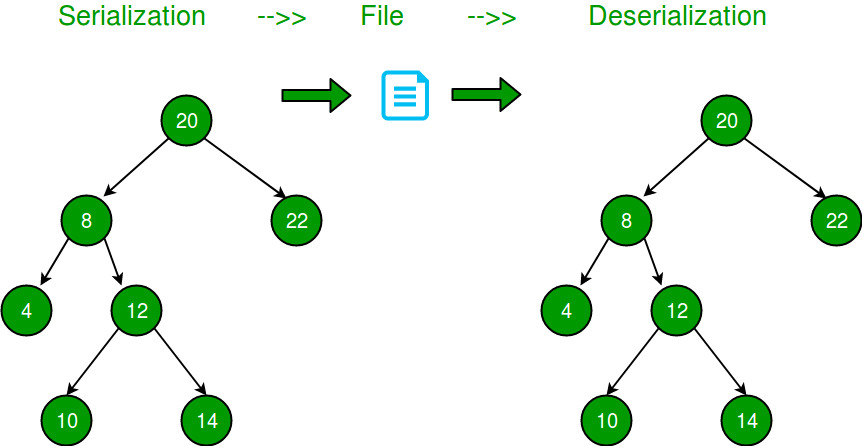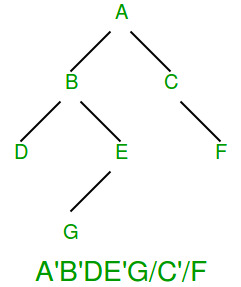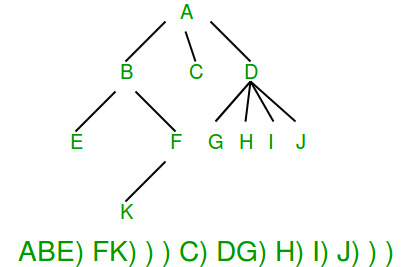序列化和反序列化二叉树
序列化是将树存储在一个文件中,以便以后可以恢复它。必须保持树的结构。反序列化是从文件中读回树。

以下是该问题的一些更简单的版本:
如果给定的树是二叉搜索树?
如果给定的二叉树是二叉搜索树,我们可以通过存储前序或后序遍历来存储它。在二叉搜索树的情况下,仅前序或后序遍历就足以存储结构信息。
如果给定的二叉树是完整的树?
如果除了最后一层之外的所有层都被完全填满并且最后一层的所有节点都尽可能地离开,那么二叉树就是完整的(二叉堆是完整的二叉树)。对于一棵完整的二叉树,层序遍历足以存储树。我们知道第一个节点是根节点,接下来的两个节点是下一级节点,接下来的四个节点是第二级节点,依此类推。
如果给定的二叉树是全树?
完整的二叉树是一个二叉树,其中每个节点都有 0 或 2 个子节点。序列化这样的树很容易,因为每个内部节点都有 2 个子节点。我们可以简单地存储前序遍历并在每个节点上存储一个位,以指示该节点是内部节点还是叶节点。
如何存储一般的二叉树?
一个简单的解决方案是存储 Inorder 和 Preorder 遍历。此解决方案需要两倍于二叉树大小的空间。
我们可以通过存储 Preorder 遍历和 NULL 指针的标记来节省空间。
Let the marker for NULL pointers be '-1'
Input:
12
/
13
Output: 12 13 -1 -1 -1
Input:
20
/ \
8 22
Output: 20 8 -1 -1 22 -1 -1
Input:
20
/
8
/ \
4 12
/ \
10 14
Output: 20 8 4 -1 -1 12 10 -1 -1 14 -1 -1 -1
Input:
20
/
8
/
10
/
5
Output: 20 8 10 5 -1 -1 -1 -1 -1
Input:
20
\
8
\
10
\
5
Output: 20 -1 8 -1 10 -1 5 -1 -1反序列化可以通过简单地从文件中一个一个地读取数据来完成。
以下是上述思想的实现。
C
// A C program to demonstrate serialization and deserialization of
// Binary Tree
#include
#define MARKER -1
/* A binary tree Node has key, pointer to left and right children */
struct Node
{
int key;
struct Node* left, *right;
};
/* Helper function that allocates a new Node with the
given key and NULL left and right pointers. */
Node* newNode(int key)
{
Node* temp = new Node;
temp->key = key;
temp->left = temp->right = NULL;
return (temp);
}
// This function stores a tree in a file pointed by fp
void serialize(Node *root, FILE *fp)
{
// If current node is NULL, store marker
if (root == NULL)
{
fprintf(fp, "%d ", MARKER);
return;
}
// Else, store current node and recur for its children
fprintf(fp, "%d ", root->key);
serialize(root->left, fp);
serialize(root->right, fp);
}
// This function constructs a tree from a file pointed by 'fp'
void deSerialize(Node *&root, FILE *fp)
{
// Read next item from file. If there are no more items or next
// item is marker, then return
int val;
if ( !fscanf(fp, "%d ", &val) || val == MARKER)
return;
// Else create node with this item and recur for children
root = newNode(val);
deSerialize(root->left, fp);
deSerialize(root->right, fp);
}
// A simple inorder traversal used for testing the constructed tree
void inorder(Node *root)
{
if (root)
{
inorder(root->left);
printf("%d ", root->key);
inorder(root->right);
}
}
/* Driver program to test above functions*/
int main()
{
// Let us construct a tree shown in the above figure
struct Node *root = newNode(20);
root->left = newNode(8);
root->right = newNode(22);
root->left->left = newNode(4);
root->left->right = newNode(12);
root->left->right->left = newNode(10);
root->left->right->right = newNode(14);
// Let us open a file and serialize the tree into the file
FILE *fp = fopen("tree.txt", "w");
if (fp == NULL)
{
puts("Could not open file");
return 0;
}
serialize(root, fp);
fclose(fp);
// Let us deserialize the stored tree into root1
Node *root1 = NULL;
fp = fopen("tree.txt", "r");
deSerialize(root1, fp);
printf("Inorder Traversal of the tree constructed from file:\n");
inorder(root1);
return 0;
} Java
// A JAVA program to demonstrate serialization and
// deserialization of Binary Tree
import java.util.*;
/* A binary tree Node has key, pointer to left and right
* children */
class TreeNode {
int val;
TreeNode left;
TreeNode right;
TreeNode(int x) { val = x; }
}
class BinaryTree {
TreeNode root;
// Encodes a tree to a single string.
public static String serialize(TreeNode root)
{
if (root == null) {
return null;
}
Stack s = new Stack<>();
s.push(root);
List l = new ArrayList<>();
while (!s.isEmpty()) {
TreeNode t = s.pop();
// If current node is NULL, store marker
if (t == null) {
l.add("#");
}
else {
// Else, store current node and recur for
// its children
l.add("" + t.val);
s.push(t.right);
s.push(t.left);
}
}
return String.join(",", l);
}
static int t;
// Decodes your encoded data to tree.
public static TreeNode deserialize(String data)
{
if (data == null)
return null;
t = 0;
String[] arr = data.split(",");
return helper(arr);
}
public static TreeNode helper(String[] arr)
{
if (arr[t].equals("#"))
return null;
// create node with this item and recur for children
TreeNode root
= new TreeNode(Integer.parseInt(arr[t]));
t++;
root.left = helper(arr);
t++;
root.right = helper(arr);
return root;
}
// A simple inorder traversal used for testing the
// constructed tree
static void inorder(TreeNode root)
{
if (root != null) {
inorder(root.left);
System.out.print(root.val + " ");
inorder(root.right);
}
}
/* Driver program to test above functions*/
public static void main(String args[])
{
// Let us construct a tree shown in the above figure
BinaryTree tree = new BinaryTree();
tree.root = new TreeNode(20);
tree.root.left = new TreeNode(8);
tree.root.right = new TreeNode(22);
tree.root.left.left = new TreeNode(4);
tree.root.left.right = new TreeNode(12);
tree.root.left.right.left = new TreeNode(10);
tree.root.left.right.right = new TreeNode(14);
String serialized = serialize(tree.root);
System.out.println("Serialized view of the tree:");
System.out.println(serialized);
System.out.println();
// Let us deserialize the stored tree into root1
TreeNode t = deserialize(serialized);
System.out.println(
"Inorder Traversal of the tree constructed from serialized String:");
inorder(t);
}
} 输出:
Inorder Traversal of the tree constructed from file:
4 8 10 12 14 20 22上述解决方案需要多少额外空间?
如果有 n 个键,则上述解决方案需要 n+1 个标记,这在键很大或键具有与之关联的大数据项的情况下可能比简单的解决方案(存储两次键)更好。
我们可以进一步优化它吗?
上述解决方案可以通过多种方式进行优化。如果我们仔细查看上面的序列化树,我们可以观察到所有叶节点都需要两个标记。一个简单的优化是为每个节点存储一个单独的位,以指示该节点是内部的还是外部的。这样我们就不必为每个叶子节点存储两个标记,因为叶子可以通过额外的位来识别。我们仍然需要一个子节点的内部节点标记。例如在下图中,' 用于表示内部节点集位,'/' 用作 NULL 标记。该图取自这里。

请注意,二叉树中的叶子节点总是比内部节点多(叶子节点的数量是内部节点的数量(度数为 2)加 1,因此这种优化是有意义的。
如何序列化n叉树?
在 n 叉树中,没有指定的左孩子或右孩子。我们可以为每个节点存储一个“子节点结束”标记。下图显示了序列化,其中 ')' 用作子标记的结尾。我们将很快介绍 n 叉树的实现。该图取自这里。
